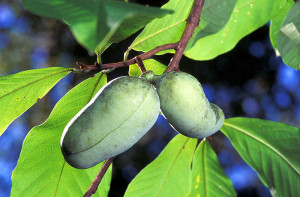Southern Bounty: How to Grow and Enjoy Southeastern Native Fruits and Nuts
Trey Watson

When I was growing up, I spent a ton of time in the woods. Even as an adolescent, I roamed the woods, looking for and learning about edible plants. I grew up in eastern Texas, a place that I still call home, and there I studied virtually everything that grows wild and is edible. Over the years, I’ve eaten hickory nuts, pecans, black walnuts, dewberries, and muscadines, all from uncultivated, wild plants.
My attraction to all things plant-related led me to get a degree in horticulture, and about 10 years ago I started a little plant nursery. We went online three years ago, with a focus on growing and selling quality fruit trees for Southern gardeners.
This past year we were able to start selling several native trees, and I was amazed at the demand for them.
But I shouldn’t have been. Think about it – what other type of plant lives as long, is as virtually pest free, bears fruit or nuts as consistently, and is as overall easy to grow? They’re not usually available at big box store garden centers, and the fruit is usually not available in the supermarket. Maybe that’s the reason so many people overlook them.
I know there are native plant societies in most states, and native plants are increasingly popular. For those of us to like to grow plants that yield fruit, natives offer an incredible, almost untapped opportunity. In the razzmatazz of the “bigger is better†plant breeding successes and marketing that we are all used to, planting a native blueberry plant for fruit production, or maintaining a stately black walnut tree even though the nut husks can stain the driveway, can be an almost revolutionary gardening act.
The southeastern U.S. is home to more than a dozen fruit and nut bearing native plants, in addition to the many edible wild plants, such a Smilax vines, which have certain parts that can be consumed. Most of these species were important food staples of native people that lived here millennia before European contact.  In some cases, wild plants were cultivated by Native Americans, who killed competing plants, fended off wildlife, and added manure to groves of fruit bearing plants. Early settlers likewise used the wild bounty for survival.
As more cultivated plants became available to the public, the native plants slowly lost favor. Most of today’s plant nurseries and almost all modern yards are completely devoid of plants that were once an essential part of Southern landscapes and diets. Logging, urban sprawl, and other land disturbances have made some of the native fruit and nut plants rare even where they once thrived.
The real point of this post is to encourage the reader to take a look at natives when looking for fruit-bearing plants. I’m a big believer in growing everything – natives, big juicy apples, fat plums, etc. I’ve made it my personal mission to encourage people to use plants like serviceberry, wild plum, and mayhaw in home landscapes, gardens, and orchards.
I recently published a book about growing, propagating, harvesting, and preserving the harvest of more than a dozen southeastern native fruit and nut trees. It is my hope that this book, Southern Bounty, provides at least a start for gardeners who want to grow and enjoy the wild fruits and nuts we’ve been blessed with here in the southeastern U.S. The hardest part of growing some of these plants is finding them to begin with. Once you’ve done that, you’re in for decades of production, all courtesy of the wild bounty that calls the southeastern U.S. home.


Leave a Reply